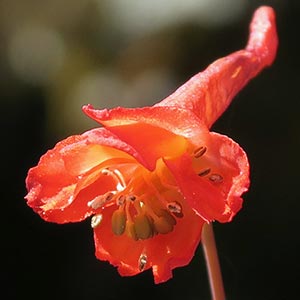Delphinium nudicaule
Delphinium decorum
canyon delphinium, canyon larkspur, orange larkspur, red larkspur, red or orange larkspur, scarlet larkspur
coast larkspur, coastal larkspur, larkspur, low larkspur, yellowtinge larkspur
(15-)20-50(-125) cm;
base reddish, glabrous.
5-25(-42) cm;
base reddish or not, at least two proximal internodes long-pubescent.
blade round to pentagonal, 2-6 × 3-10 cm; ultimate lobes 3-12, width 5-40 mm (basal), 2-20 mm (cauline).
blade deltate to pentagonal, 1-2.5 × 1.5-4.5 cm, ± puberulent; ultimate lobes 3-15, width 3-17 mm (basal), 1-8 mm (cauline), widest at middle or in proximal 1/2.
5-20(-69)-flowered;
pedicel (1.5-)2-6(-8) cm, glabrous to glandular-pubescent;
bracteoles 14-20(-30) mm from flowers, green to red, linear, 2-4(-9) mm, glabrous to puberulent.
2-10(-20)-flowered;
pedicel 1-4(-6) cm, puberulent to glabrous;
bracteoles (3-)7-11(-21) mm from flowers, green to blue, linear-lanceolate, 6-9(-12) mm, puberulent.
sepals scarlet to reddish orange, rarely dull yellow, glabrous, lateral sepals forward-pointing to form pseudotube, (6-)8-13(-16) × 3-6 mm, spurs straight, slightly ascending, (12-)18-27(-34) mm;
lower petal blades elevated, exposing stamens, 2-3 mm, clefts 0.5-1 mm;
hairs sparse, evenly dispersed, yellow.
sepals bluish purple (somewhat faded on drying), puberulent, lateral sepals spreading, (11-)15-20(-24) × 6-11(-15) mm, spur straight, 0-30° above horizontal, 13-20 mm;
lower petal blades ± covering stamens, 6-11 mm, cleft 2-4 mm;
hairs on entire surface, densest on inner lobes, yellow or white.
13-26 mm, 3.5-4.5 times longer than wide, glabrous.
9-20 mm, 3-4.5 times longer than wide, glabrous to puberulent.
unwinged or sometimes slightly wing-margined;
seed coat cells with surfaces smooth.
wing-margined;
seed coat cells ± aggregate in small wavy ridges, cell surfaces ± roughened, without swollen, blunt hairs.
= 16.
Delphinium nudicaule
Delphinium decorum
Delphinium nudicaule hybridizes with most other taxa of Delphinium that it encounters. Apparent hybrids involving D. nudicaule, and seen by the author (either afield or as specimens), include D. andersonii, D. antoninum, D. decorum, D. luteum, D. nuttallianum, D. patens, and D. trolliifolium. In addition, garden-grown plants have been hybridized with D. cardinale, D. elatum, D. menziesii, D. parishii, D. penardii, D. tatsienense Franchet, D. triste Fischer ex de Candolle, and D. uliginosum; D. nudicaule does not naturally occur with these species. Delphinium nudicaule is one of the earliest larkspurs to flower in any given locality. Douglas's type collection of D. nudicaule represents plants (synonyms D. sarcophyllum Hooker & Arnott and D. peltatum Hooker, an invalid name) grown under very moist conditions, probably quite near the ocean. The type specimen of D. armeniacum A. Heller represents plants grown under unusually dry conditions.
The Mendocino Indians consider Delphinium nudicaule a narcotic (D. E. Moerman 1986).
(Discussion copyrighted by Flora of North America; reprinted with permission.)
Subspecies 2 (2 in the flora).
Delphinium decorum and D. menziesii have been confused. Delphinium menziesii usually has darker, colorfast (nonfading) sepals with less lavender, and a more northern distribution than D. decorum. It also has more finely dissected leaves than D. decorum subsp. decorum.
Often confused with Delphinium patens, D. decorum is sometimes circumscribed to include that species. The spreading, fading, blue-purple sepals, pubescent proximal portion of stems, and large lower petal blade of D. decorum, compared to the reflexed, colorfast, bluer sepals, proximally glabrous stems, and smaller lower petal blades of D. patens, adequately distinguish the two taxa.
(Discussion copyrighted by Flora of North America; reprinted with permission.)
1. Leaf blade usually with 3–5 lobes longer than 1/2 leaf radius; 0–100 m. | subsp. decorum |
1. Leaf blade usually with more than 5 lobes longer than 1/2 leaf radius; 700–2300 m. | subsp. tracyi |


